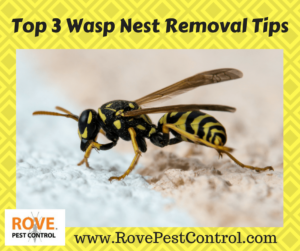wasp nest removal often presents a daunting task for many homeowners and businesses alike. Depending on the type of wasps present and the size of the nest, removing it can be an intimidating endeavor that should only be handled in specific ways by experts. The following is a comprehensive guide to help you learn more about wasp nest removal and how to do it safely and effectively.
What are the Different Types of Wasps?
Wasps are typically divided into two primary categories: social wasps and solitary wasps. Social wasps include yellow jackets, hornets, and paper wasps. These species live in larger group nests, typically underground or in trees. Solitary wasps tend to build individual nests or colonies, often made from mud, wood, or other materials. Examples of these species include mud daubers and mason wasps.
When is the Best Time to Remove a Wasp Nest?
The ideal time to remove a wasp nest will depend on the type of wasp present. Social wasp nests are best removed at dusk when most of the wasps have returned home for the night. This also gives homeowners and professionals enough time to prepare for protection if necessary. For solitary wasps, their nests can be removed anytime since the sole inhabitant usually returns to a different nest each night.

How to Safely Carry out Wasp Nest Removal
When considering wasp nest removal, safety should always be the number one priority. The safest way to remove a wasp nest is to use a professional exterminator equipped with proper safety equipment. Some expert exterminators may even employ insecticides and special traps to rid the area of wasps. It’s important to note that any attempt to remove a wasp nest without protective equipment is dangerous and should not be attempted.
Practical Tips for Wasp Nest Removal
If attempting to remove the nest yourself is your only option, here are some practical tips to help ensure a safe process: Choose dusk as the ideal time, approach slowly and quietly, wear protective clothing and gear, keep a flashlight handy for illuminating dark spaces, and use a long-handled tool like a rake or broom to knock down the nest from a distance.
Signs of an Infestation
It’s important to be aware of the signs of a wasp infestation so you can quickly identify and take action accordingly. Common signs of infestation include wasp nests built in high places; large numbers of wasps hovering around windows and doors; and swarms of wasps in specific areas.
Damage Caused by Wasp Nests
In addition to being aggressive, wasps can cause significant structural damage to homes and buildings. As they build their nests, they create holes in attics, walls, and other areas of the property. If left alone, they can weaken building structures which can lead to costly repairs. Besides the physical damage, wasps can also cause health risks such as allergic reactions, which can be life-threatening in some cases.
Wasp nest removal can be a serious undertaking that requires attention to detail and knowledge of proper safety procedures. By following the guidelines set forth in this article, you’ll be better prepared to go about wasp nest removal in the safest, most effective way possible.
